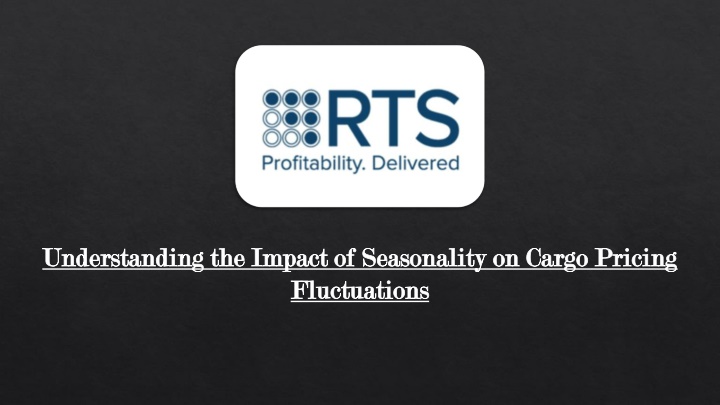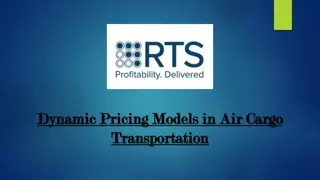Understanding the Impact of Seasonality on Cargo Pricing Fluctuations
In the dynamic realm of cargo transportation, where the movement of goods fuels global trade, pricing fluctuations are not just commonplace but often expected. At the heart of these fluctuations lies the intricate dance between supply and demand, influenced significantly by seasonality. Understanding the role of seasonality in cargo pricing fluctuations is essential for revenue technology services to optimize strategies and navigate the complexities of the market effectively.n
Download Presentation

Please find below an Image/Link to download the presentation.
The content on the website is provided AS IS for your information and personal use only. It may not be sold, licensed, or shared on other websites without obtaining consent from the author.If you encounter any issues during the download, it is possible that the publisher has removed the file from their server.
You are allowed to download the files provided on this website for personal or commercial use, subject to the condition that they are used lawfully. All files are the property of their respective owners.
The content on the website is provided AS IS for your information and personal use only. It may not be sold, licensed, or shared on other websites without obtaining consent from the author.
E N D
Presentation Transcript
Understanding the Impact of Seasonality on Cargo Pricing Understanding the Impact of Seasonality on Cargo Pricing Fluctuations Fluctuations
In the dynamic realm of cargo transportation, where the movement of goods fuels global trade, pricing fluctuations are not just commonplace but often expected. At the heart of these fluctuations lies the intricate dance between supply and demand, influenced significantly by seasonality. Understanding the role of seasonality in cargo pricing fluctuations is essential for revenue technology services to optimize strategies and navigate the complexities of the market effectively. Cargo dynamic pricing, a sophisticated approach to setting prices based on real-time supply and demand dynamics, has become increasingly prevalent in the logistics industry. Yet, despite its advancements, this pricing model remains heavily influenced by seasonal variations. Seasonality exerts a profound impact on cargo transportation, affecting both supply chains and pricing strategies in profound ways.
One of the primary drivers of seasonal fluctuations in cargo pricing is the cyclical nature of demand. Different industries experience peaks and troughs throughout the year, driven by various factors such as consumer behavior, weather patterns, and holidays. For instance, the retail sector often witnesses heightened activity during the holiday season, leading to increased demand for transportation services to fulfill orders. Conversely, industries like agriculture may experience fluctuations based on harvest seasons or weather conditions affecting crop yields. Moreover, seasonal events and phenomena can disrupt supply chains and lead to imbalances between supply and demand, thereby influencing pricing dynamics. Natural disasters, such as hurricanes or typhoons, can disrupt port operations and transportation networks, causing delays and shortages in cargo availability. These disruptions often result in surges in pricing as logistics providers scramble to meet demand amidst constrained capacity. Furthermore, geopolitical factors and regulatory changes can compound the effects of seasonality on cargo pricing fluctuations. Trade tensions, tariffs, and shifts in government policies can disrupt established trade routes and alter supply chain dynamics, leading to fluctuations in pricing as businesses adapt to new realities. For revenue technology services tasked with optimizing cargo pricing strategies, leveraging data analytics and predictive modeling is crucial. By analyzing historical trends and seasonal patterns, revenue technology services can anticipate demand fluctuations and adjust pricing dynamically to maximize profitability. Advanced algorithms can identify correlations between seasonality, market trends, and pricing dynamics, enabling companies to make informed decisions in real-time.
Additionally, collaboration and communication across the supply chain are paramount in mitigating the impacts of seasonality on cargo pricing fluctuations. Close coordination between shippers, carriers, and freight forwarders can help identify potential bottlenecks and proactively address supply chain disruptions. By fostering transparency and agility, stakeholders can adapt swiftly to changing market conditions and optimize pricing strategies accordingly. In conclusion, seasonality plays a pivotal role in shaping cargo pricing fluctuations, influencing supply and demand dynamics in the logistics industry. Revenue technology services must harness the power of data analytics and predictive modeling to navigate these fluctuations effectively. By understanding the nuances of seasonality and collaborating closely across the supply chain, businesses can optimize pricing strategies and thrive in a dynamic and ever-changing market landscape.
THANK YOU THANK YOU























